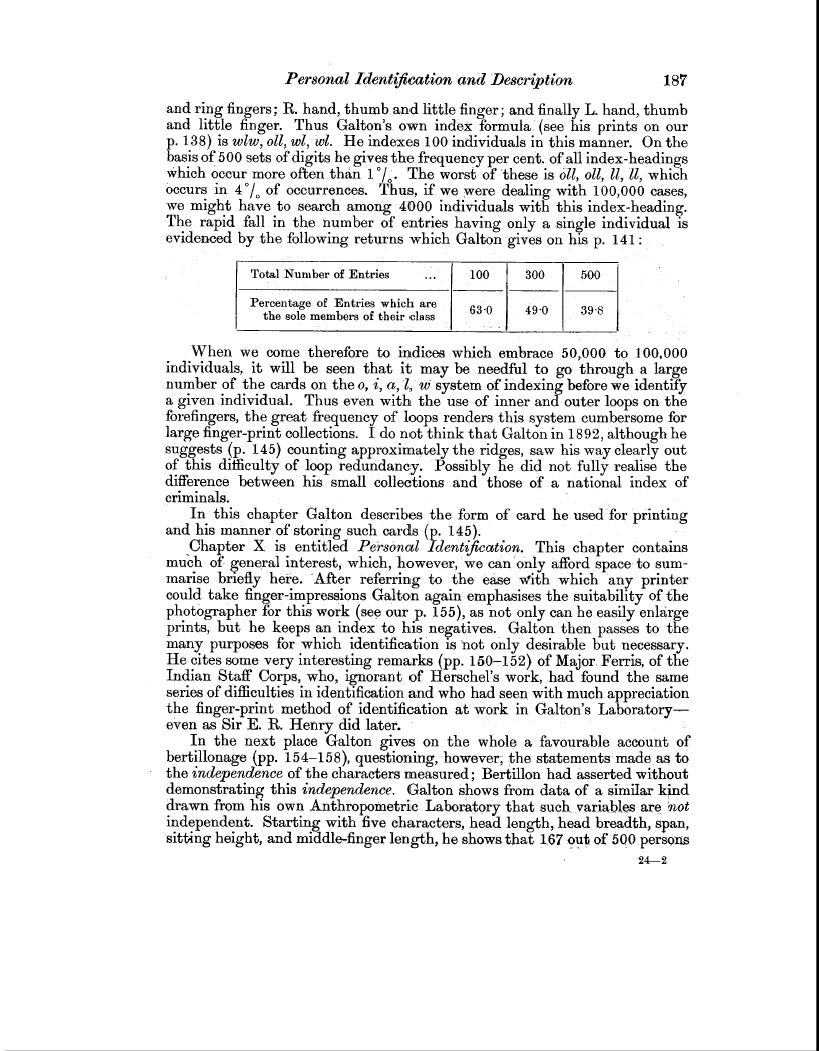| ||||||

OCR Rendition - approximate
Personal Identification and Description 187 and ring fingers; R. hand, thumb and little finger; and finally L. hand, thumb and little finger. Thus Galton's own index formula (see his prints on our p. 138) is wlw, oll, wl, wl. He indexes 100 individuals in this manner. On the basis of 500 sets of digits he gives the frequency per cent. of all index-headings which occur more often than I'/,. The worst of 'these is oll, oll, 11, ii, which occurs in 4'/. of occurrences. Thus, if we were dealing with 100,000 cases, we might have to search among 4000 individuals with this index-heading. The rapid fall in the number of entries having only a single individual is evidenced by the following returns which Galton gives on his p. 141:
When we come therefore to indices which embrace 50,000 to 100,000 individuals, it will be seen that it may be needful to go through a large number of the cards on the o, i, a, 1, w system of indexing before we identify a given individual. Thus even with the use of inner and outer loops on the forefingers, the great frequency of loops renders this system cumbersome for large finger-print collections. I do not think that Galton in 1892, although he suggests (p. 145) counting approximately the ridges, saw his way clearly out of this difficulty of loop redundancy. Possibly he did not fully realise the difference between his small collections and those of a national index of criminals. In this chapter Galton describes the form of card he used for printing and his manner of storing such cards (p. 145). Chapter X is entitled Personal Identification. This chapter contains much of general interest, which, however, we can only afford space to summarise briefly here. After referring to the ease with which any printer could take finger-impressions Galton again emphasises the suitability of the photographer for this work (see our p. 155), as not only can he easily enlarge prints, but he keeps an index to his negatives. Galton then passes to the many purposes for which identification is not only desirable but necessary. He cites some very interesting remarks (pp. 150-152) of Major. Ferris, of the Indian Staff Corps, who, ignorant of Herschel's work, had found the same series of difficulties in identification and who had seen with much appreciation the finger-print method of identification at work in Galton's Laboratoryeven as Sir E. R. Henry did later. In the next place Galton gives on the whole a favourable account of bertillonage (pp. 154-158), questioning, -however, the statements made as to the independence of the characters measured; Bertillon had asserted without demonstrating this independence. Galton shows from data of a similar kind independent. drawn from 1 Starting P Laboratory that such variabless are not g with five chcharacters, head length, head breadth, span, sitting height, and middle-finger length, he shows that 167 out of 500 persons 24-2
|